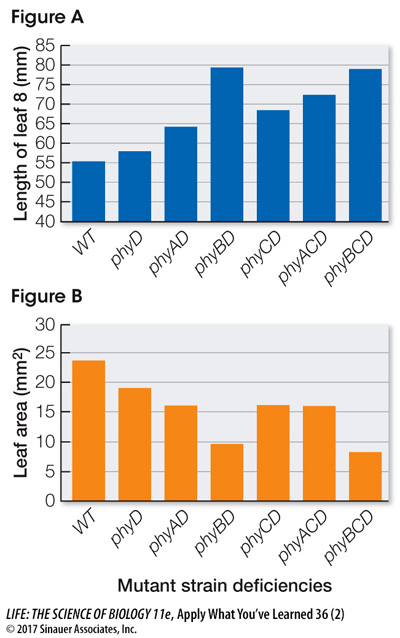Apply What You’ve Learned
785
Review
36.1 Plants respond to environmental cues during growth by the use of signal transduction pathways involving hormones and photoreceptors.
36.1 Scientists use genetic screens to identify genes involved in the control of growth and development.
Original Papers: Franklin, K. A., S. J. Davis, W. M. Stoddart, R. D. Vierstra and G. C. Whitelam. 2003. Mutant analyses define multiple roles for phytochrome C in Arabidopsis photomorphogenesis. The Plant Cell 15: 1981–
Qin, M., R. Kuhn, S. Moran and P. H. Quail. 1997. Overexpressed phytochrome C has similar photosensory specificity to phytochrome B but a distinctive capacity to enhance primary leaf expansion. The Plant Journal 12: 1163–
Sharrock, R. A. and T. Clack. 2002. Patterns of expression and normalized levels of the five Arabidopsis phytochromes. Plant Physiology 130: 442–
Phytochromes sense red (R) and far-
Elucidating the roles of the phy genes has involved both molecular and genetic approaches. In one molecular approach, a gene is coupled to a very active promoter and expressed at higher than normal levels (overexpressed) in developing Arabidopsis plants. For example, phyA, phyB, phyC, and phyD were separately overexpressed in Arabidopsis, and 18-
| Gene expression | Leaf area (mm2) |
|---|---|
| Wild type | 22 |
| phyA overexpressed | 21 |
| phyB overexpressed | 21 |
| phyC overexpressed | 31 |
| phyD overexpressed | 22 |
To complement the molecular approach, a genetic approach—

Questions
Question 1
What do the data in the table indicate about the role of the four phytochrome genes in leaf development?
Acting alone, phyC enhances leaf area, whereas phyA, phyB, and phyD do not.
Question 2
How would would a genetic screen for phyC-deficient mutants be done, and what phenotype would be examined in the screen?
Arabidopsis seeds would be treated with a mutagen and planted. Those plants with reduced leaf size would be isolated and grown to examine for phyC mutations.
Question 3
Compare the results for phyAD, phyCD, and phyACD in Figure B. What do these results tell you about the function and necessity of the phyA and phyC gene in controlling Arabidopsis leaf area?
The leaf area phenotypes produced by these three conditions are equal. All three groups have leaf areas about one-
Question 4
What do the data in Figures A and B suggest about the function of the gene phyB in leaf growth? How does its function relate to the function(s) of phyA and phyC?
A deficiency in phyB causes a very long leaf (a long petiole) and a very small leaf area (small leaf). This suggests that, if this gene were functional, it would control leaf growth by greatly inhibiting petiole length and greatly increasing leaf area. This would produce a leaf with a large surface area for photosynthesis, which could be highly adaptive. PhyA and phyC have the same effect on leaf area as phyB, but to a lesser extent. PhyA and phyC also inhibit petiole length, with phyA having the greater effect and phyC adding slightly to this effect. It is likely that, in plants in nature, the control of these two leaf features results from the ratio of the various phytochromes present.